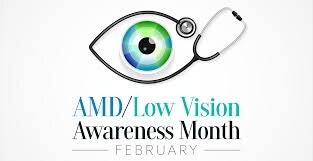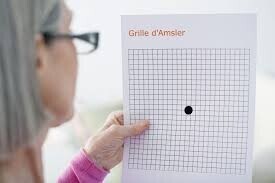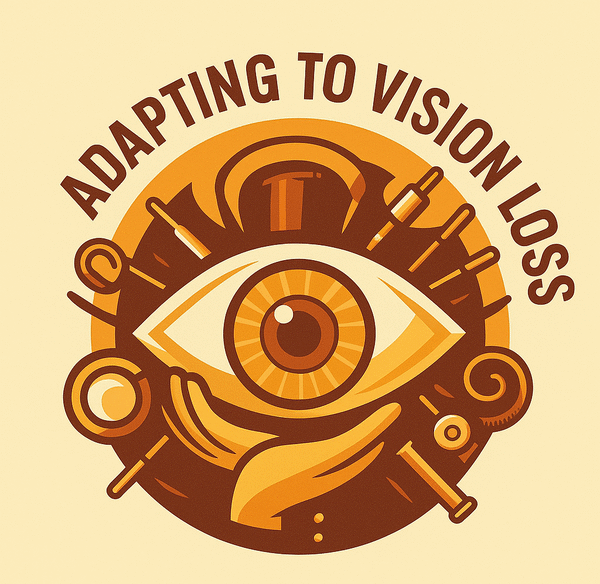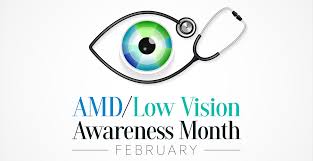
February stands out as an important month when we focus on bringing attention to Age-Related Macular Degeneration (AMD) and Low Vision Awareness. It’s not just another health observance; it’s a time to raise the profile of these serious vision issues that can drastically affect the lives of those we love.
AMD is one of the leading causes of vision loss, particularly among older adults. As people age, they face a higher risk of this degenerative eye condition that primarily affects the central vision, which is crucial for activities like reading, driving, and recognizing faces.
In this article, we’ll cover what AMD and low vision are, who is at risk, and what the public can do to help those affected.
Low vision is another significant concern. It’s not the same as blindness. Instead, it’s a type of eye condition where the level of vision impairment makes it hard to perform daily tasks, even with glasses, contact lenses, or surgery. Knowing the difference is vital since it helps identify those who need specific support or resources, aiming to improve their quality of life.
By increasing awareness around these conditions, February serves as a reminder of the importance of eye health and the steps we can take to protect our vision or assist those who face these challenges. Being knowledgeable about AMD and low vision can set the foundation for effective prevention strategies, advocacy, and support systems for those affected.
Understanding AMD and Low Vision: What They Entail
Age-Related Macular Degeneration (AMD) is a progressive eye disease that primarily impacts the central portion of vision, crucial for detailed tasks like reading and recognizing faces. Although it doesn’t lead to complete blindness, AMD significantly hampers a person’s ability to see clearly in the center of their gaze.
There are two types of AMD:
- Dry AMD – The most common form, progressing slowly over time as light-sensitive cells break down.
- Wet AMD – Less common but more severe, causing rapid vision loss due to abnormal blood vessels leaking fluid under the retina.
Awareness of the risk factors associated with AMD provides insight into prevention.
Risk Factors for AMD:
- Age (50+ are at higher risk)
- Family history of AMD
- Smoking
- High blood pressure and cardiovascular disease
- Poor diet lacking leafy greens, omega-3s, and antioxidants
What is Low Vision?
Low vision is a visual impairment that cannot be corrected with standard glasses, contact lenses, or surgery. It can result from AMD, diabetic retinopathy, glaucoma, cataracts, or eye injuries. People with low vision may experience:
- Blurry vision even with glasses
- Loss of central or peripheral vision
- Difficulty seeing in low-light conditions
- Challenges with reading, recognizing faces, or driving
Understanding that some people might already show early signs of AMD without knowing it underscores the necessity of regular eye check-ups. Raising awareness about both AMD and low vision is a step towards proactive eye health management.
The Importance of Early Detection: Preventing Further Deterioration
Catching AMD and low vision issues early on can make all the difference in managing and slowing their progression. Regular eye exams are a key preventive measure, especially if you’re over 50. Getting checked routinely can help spot early signs before they start interfering with your daily life.
Some early indicators to watch for include blurry or distorted central vision, straight lines appearing wavy, and trouble reading or seeing details in dim light. If you’re noticing any of these symptoms, it’s a good idea to schedule a visit to the eye doctor.
One simple and effective tool for self-monitoring is the Amsler Grid test. It’s a straightforward way to check for any disruptions or changes in your field of vision at home. This proactive step can alert you to problems that need professional attention sooner rather than later.
Low vision is a visual impairment that cannot be corrected with standard glasses, contact lenses, or surgery. It can result from AMD, diabetic retinopathy, glaucoma, cataracts, or eye injuries. People with low vision may experience:
- Blurry vision even with glasses
- Loss of central or peripheral vision
- Difficulty seeing in low-light conditions
- Challenges with reading, recognizing faces, or driving
Low vision is a visual impairment that cannot be corrected with standard glasses, contact lenses, or surgery. It can result from AMD, diabetic retinopathy, glaucoma, cataracts, or eye injuries. People with low vision may experience:

How to Test at Home: The Amsler Grid Test
The Amsler Grid is a simple tool that can detect vision changes caused by AMD. To use it:
- Cover one eye and focus on the center dot of the grid.
- Note if lines appear wavy, missing, or distorted.
- Repeat with the other eye.
- If you notice abnormalities, see an eye specialist immediately.
Raising awareness is equally vital. Sharing experiences and stories of dealing with vision loss helps build a supportive community and can motivate others to engage in preventive care. Supporting organizations that fund research or provide resources for those with AMD and low vision adds another layer of community aid.
Encouraging regular eye exams among those around you isn’t just a preventive measure; it raises collective consciousness about the importance of eye health. As more people get involved, the stronger the support network grows, benefiting everyone touched by these conditions.
Resources and Tools for Coping with AMD and Low Vision
Living with AMD and low vision can be challenging, but knowing where to find help and resources makes a big difference.
There are many resources available to help people with AMD and vision impairment maintain independence:
Embracing assistive technologies can greatly enhance independence for those with vision impairments. Tools like screen readers, magnifiers, and talking devices cater to various needs, allowing users to engage more fully with their surroundings and daily tasks. Innovation in this field continues to improve the ways individuals can maintain independence.
Assistive Technology & Adaptive Aids:
- Screen readers (JAWS, NVDA, VoiceOver)
- Electronic magnifiers and CCTV systems
- Smart home assistants (Amazon Alexa, Google Home) for voice-activated control
- Large-print books, talking watches, and tactile labels
Organizations play a pivotal role in supporting those with vision impairments. Joining forces with entities like the National Eye Institute, Prevent Blindness, and the American Macular Degeneration Foundation ensures access to the latest research, resources, and advocacy efforts. These organizations often provide crucial updates about clinical trials, treatment breakthroughs, and educational materials.
Support Groups and Organizations:
- American Macular Degeneration Foundation – Research, education, and support.
- National Eye Institute – Information on eye diseases and treatment.
- Prevent Blindness – Advocacy and educational resources.
Navigating life with AMD or low vision can be less daunting when equipped with the right tools and connections. By exploring available resources, individuals can enhance their quality of life and remain active participants in their communities. Encouraging others to seek out these resources fosters an environment of awareness, support, and shared knowledge.
February’s AMD & Low Vision Awareness Month is a critical time to educate others about early detection and provide support for those living with vision loss. Whether through raising awareness, offering support, or taking preventative steps, everyone can play a role in fighting AMD and improving the lives of those with low vision.
Take Action Today!
✅ Schedule an eye exam – or encourage a loved one to do so.
✅ Share this article to help spread awareness.
✅ Support organizations that assist people with AMD and low vision.
Do you or someone you know have AMD? What has helped the most? Share your thoughts in the comments!

